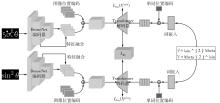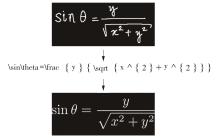Journal of South China University of Technology(Natural Science Edition) ›› 2024, Vol. 52 ›› Issue (2): 23-31.doi: 10.12141/j.issn.1000-565X.230034
• Computer Science & Technology • Previous Articles Next Articles
Mutual Learning Offline Handwritten Mathematical Expression Recognition Based on Multi-Scale Feature Fusion
FU Pengbin XU Yu YANG Huirong
- Faculty of Information Technology,Beijing University of Technology,Beijing 100124,China
-
Received:2023-02-06Online:2024-02-25Published:2023-04-21 -
Contact:杨惠荣(1971-),女,博士,工程师,主要从事智能信息系统研究。 E-mail:yanghuirong@bjut.edu.cn -
About author:付鹏斌(1967-),男,副教授,主要从事图形图像处理、模式识别等研究。E-mail:fupengbin@bjut.edu.cn -
Supported by:the National Natural Science Foundation of China(61772048);the Natural Science Foundation of Beijing(4153058);the Construction of High Quality Undergraduate Courseware for Beijing Education Commission(040000514122506)
CLC Number:
Cite this article
FU Pengbin, XU Yu, YANG Huirong. Mutual Learning Offline Handwritten Mathematical Expression Recognition Based on Multi-Scale Feature Fusion[J]. Journal of South China University of Technology(Natural Science Edition), 2024, 52(2): 23-31.
share this article
Table 6
Multi-scale feature fusion mechanism and mutual learning mechanism experiments"
| 数据集 | 模型 | Acc | Err1 | Err2 | Wer |
|---|---|---|---|---|---|
| CROHME 2014 | BTTR | 53.96 | 66.02 | 70.28 | |
| BTTR-MS | 55.25 | 73.39 | 80.53 | 10.46 | |
| BTTR-KL | 55.43 | 72.69 | 81.22 | 9.80 | |
| Ours | 56.36 | 72.89 | 81.12 | 9.78 | |
| CROHME 2016 | BTTR | 52.31 | 63.90 | 68.61 | |
| BTTR-MS | 52.31 | 69.66 | 78.12 | 10.96 | |
| BTTR-KL | 53.53 | 71.84 | 80.03 | 10.34 | |
| Ours | 53.88 | 71.40 | 79.77 | 10.48 | |
| CROHME 2019 | BTTR | 52.96 | 65.97 | 69.14 | |
| BTTR-MS | 53.72 | 72.43 | 80.03 | 9.86 | |
| BTTR-KL | 53.79 | 71.23 | 79.57 | 10.27 | |
| Ours | 55.21 | 73.23 | 80.82 | 9.31 |
Table 7
CROHME dataset comparison experiment"
| 数据集 | 模型 | Acc | Err1 | Err2 |
|---|---|---|---|---|
| CROHME2014 | WAP | 46.55 | 61.15 | 65.21 |
| DWAP | 50.10 | |||
| DWAP-MSA | 52.80 | 68.10 | 72.00 | |
| DWAP-TD | 49.10 | 64.20 | 67.80 | |
| PAL | 39.66 | 56.80 | 65.11 | |
| PAL-v2 | 48.88 | 64.50 | 69.78 | |
| Dual Loss | 51.88 | |||
| BTTR | 53.96 | 66.02 | 70.28 | |
| ABM | 56.85 | 73.73 | 81.24 | |
| SAN | 56.20 | 72.60 | 79.20 | |
| Ours | 56.36 | 72.89 | 81.12 | |
| Ours* | 58.88 | 74.92 | 84.14 | |
| CROHME2016 | WAP | 44.55 | 57.10 | 61.55 |
| DWAP | 47.50 | |||
| DWAP-MSA | 50.10 | 63.80 | 67.40 | |
| DWAP-TD | 48.50 | 62.30 | 65.30 | |
| PAL-v2 | 49.61 | 64.08 | 70.27 | |
| Dual Loss | 51.53 | |||
| BTTR | 52.31 | 63.90 | 68.61 | |
| ABM | 52.92 | 69.66 | 78.73 | |
| SAN | 53.60 | 69.60 | 76.80 | |
| Ours | 53.88 | 71.40 | 79.77 | |
| Ours* | 55.10 | 69.83 | 78.64 | |
| CROHME2019 | DWAP-TD | 51.40 | 66.10 | 69.10 |
| BTTR | 52.96 | 65.97 | 69.14 | |
| ABM | 53.96 | 71.06 | 78.65 | |
| SAN | 53.50 | 69.30 | 70.10 | |
| Ours | 55.21 | 73.23 | 80.82 | |
| Ours* | 57.05 | 73.39 | 79.89 |
| 1 | MOUCHERE H, GAUDIN C V, ZANIBBI R,et al .ICFHR 2016 CROHME:competition on recognition of online handwritten mathematical expressions[C]∥Proceedings of the 2016 15th International Conference on Frontiers in Handwriting Recognition (ICFHR).Shenzhen:IEEE,2017:607-612. |
| 2 | 靳简明,江红英,王庆人 .数学公式图像处理综述 [J].模式识别与人工智能,2005,18(4):429-440. |
| JIN Jian-ming, JIANG Hong-ying, WANG Qing-ren .Survey of mathematical expression image processing[J].Pattern Recognition and Artificial Intelligence,2005,18(4):429-440. | |
| 3 | SIMISTIRA F, PAPAVASSILIOU V, KATSOUROS V,et al .Recognition of spatial relations in mathematical formulas[C]∥Proceedings of the 2014 14th International Conference on Frontiers in Handwriting Recognition (ICFHR).Hersonissos:IEEE,2014:164-168. |
| 4 | NAZEMI A, TAVAKOLIAN N, FITZPATRICK D,et al .Offline handwritten mathematical symbol recognition utilising deep learning [EB/OL].(2019-10-22)[2023-01-09].. |
| 5 | LODS A, ANQUETIL E, MACE S .Fuzzy visibility graph for structural analysis of online handwritten mathematical expressions[C]∥Proceedings of the 2019 International Conference on Document Analysis and Recognition (ICDAR).Sydney:IEEE,2019:641-646. |
| 6 | LAVANYA K, BAJAJ S, TANK P,et al .Handwritten digit recognition using hoeffding tree,decision tree and random forests—a comparative approach[C]∥Proceedings of the 2017 International Conference on Computational Intelligence in Data Science (ICCIDS).Chennai:IEEE,2017:1-6. |
| 7 | ALTAN A, KARASU S,ZIO E .A new hybrid model for wind speed forecasting combining long short-term memory neural network,decomposition methods and grey wolf optimizer[J].Applied Soft Computing,2021,106996/1-20. |
| 8 | 陈路,陈道喜,陆一鸣,等 .基于注意力机制编码器-解码器的手写数学公式识别模型[J].计算机应用,2023,43(4):1297-1302. |
| CHEN Lu, CHEN Daoxi, LU Yiming,et al .Handwritten mathematical expression recognition model based on attention mechanism and encoder-decoder[J].Journal of Computer Applications,2023,43(4):1297-1302. | |
| 9 | ZHANG J, DU J, ZHANG S L,et al .Watch,attend and parse:an end-to-end neural network based approach to handwritten mathematical expression recognition [J].Pattern Recognition,2017,71:196-206. |
| 10 | ZHANG J S, DU J, DAI L R .A GRU-based encoder-decoder approach with attention for online handwritten mathematical expression recognition[C]∥Proceedings of the 2017 14th IAPR International Conference on Document Analysis and Recognition (ICDAR).Kyoto:IEEE,2017:902-907. |
| 11 | ZHANG J S, DU J, DAI L R .Multi-scale attention with dense encoder for handwritten mathematical expression recognition[C]∥Proceedings of the 2018 24th International Conference on Pattern Recognition (ICPR).Beijing:IEEE,2018:2245-2250. |
| 12 | WU J W, YIN F, ZHANG Y M,et al .Image-to-markup generation via paired adversarial learning [C]∥Proceedings of the Machine Learning and Knowledge Discovery in Databases.Cham:Springer,2018:18-34. |
| 13 | WU J W, YIN F, ZHANG Y M,et al .Handwritten mathematical expression recognition via paired adversarial learning[J].International Journal of Computer Vision,2020,128:2386-2401. |
| 14 | LE A D .Recognizing handwritten mathematical expressions via paired dual loss attention network and printed mathematical expressions[C]∥Proceedings of the 2020 IEEE/CVF Conference on Computer Vision and Pattern Recognition Workshops (CVPRW).Seattle:IEEE,2020:2413-2418. |
| 15 | ZHAO W Q, GAO L C, YAN Z Y,et al .Handwritten mathematical expression recognition with bidirectionally trained transformer[C]∥Proceedings of the Document Analysis and Recognition-ICDAR 2021.Cham:Springer,2021:570-584. |
| 16 | BIAN X H, QIN B, XIN X Z,et al .Handwritten mathematical expression recognition via attention aggregation based bi-directional mutual learning[EB/OL].(2022-09-04)[2023-01-03].. |
| 17 | ZHANG Y, XIANG T, HOSPEDALES T M,et al .Deep mutual learning[C]∥Proceedings of the IEEE Conference on Computer Vision and Pattern Recognition (CVPR).New York:IEEE,2018:4320-4328. |
| 18 | 付鹏斌,李建君,杨惠荣 .基于粘连符号分割和多特征融合的手写公式识别[J].北京工业大学学报,2021,47(8):842-853. |
| FU Pengbin, LI Jianjun, YANG Huirong. Handwritten formula recognition based on segmentation of adhesive symbols and multi-feature fusion[J].Journal of Beijing University of Technology,2021,47(8):842-853. | |
| 19 | HUANG G, LIU Z, MAATEN V,et al .Densely connected convolutional networks[C]∥Proceedings of the 2017 IEEE Conference on Computer Vision and Pattern Recognition (CVPR).Honolulu:IEEE,2017:2261-2269. |
| 20 | VASWANI A, SHAZEER N, PARMAR N,et al .Attention is all you need[EB/OL].(2021-01-23)[2023-01-16].. |
| 21 | ZHAO W Q, GAO L C. CoMER:modeling coverage for transformer-based handwritten mathematical expression recognition [EB/OL].(2022-07-13)[2023-01-15].. |
| 22 | CARION N, MASSA F, SYNNAEVE G,et al .End-to-end object detection with transformers[C]∥Proceedings of the 16th European Conference on Computer Vision.Glasgow:Springer,2020:213-229. |
| 23 | DENG Y T, KANERVISTO A, LING J,et al .Image-to-markup generation with coarse-to-fine attention[C]∥Proceedings of the 34th International Conference on Machine Learning.[S.l.]:JMLR,2016:980-989. |
| 24 | HINTON G, VINYALS O, DEAN J .Distilling the knowledge in a neural network[EB/OL].(2018-08-13)[2023-01-15].. |
| 25 | ZHANG J S, DU J, YANG Y X,et al .A tree-structured decoder for image-to-markup generation[C]∥Proceedings of the International Conference on Machine Learning (ICML).[S.l.]:PMLR,2020:11076-11085. |
| 26 | YUAN Y, LIU X, DIKUBAB W,et al .Syntax-aware network for handwritten mathematical expression recognition[EB/OL].(2022-06-18)[2023-02-01].. |
| [1] | HU Guanghua, OU Meitong, LI Zhendong. Multi-Object Recognition and 6-DoF Pose Estimation Based on Synthetic Datasets [J]. Journal of South China University of Technology(Natural Science Edition), 2024, 52(4): 42-50. |
| [2] | CAI Xiaodong, ZHOU Qingsong, YE Qing. Social Recommendation Model Based on Dynamic Neighborhood Sampling [J]. Journal of South China University of Technology(Natural Science Edition), 2024, 52(2): 32-41. |
| [3] | TIAN Sheng, SONG Lin, ZHAO Kailong. Point Cloud Classification Based on Offset Attention Mechanism and Multi-Feature Fusion [J]. Journal of South China University of Technology(Natural Science Edition), 2024, 52(1): 100-109. |
| [4] | SUN Digang, ZHANG Ping. Hand Pose Estimation based on Prior Knowledge and Mesh Supervision [J]. Journal of South China University of Technology(Natural Science Edition), 0, (): 0-. |
| [5] | LUO Yutao, GAO Qiang. Traffic Sign Detection Based on Channel Attention and Feature Enhancement [J]. Journal of South China University of Technology(Natural Science Edition), 2023, 51(12): 64-72. |
| [6] | WANG Shiyong, QIAN Guokang, LI Di, et al.. Real-Time Template Matching Method for Edge Features [J]. Journal of South China University of Technology(Natural Science Edition), 2023, 51(9): 1-10. |
| [7] | LI Jiachun, LI Bowen, LIN Weiwei. AdfNet: An Adaptive Deep Forgery Detection Network Based on Diverse Features [J]. Journal of South China University of Technology(Natural Science Edition), 2023, 51(9): 82-89. |
| [8] | LI Haiyan, YIN Haolin, LI Peng, et al.. Image Inpainting Algorithm Based on Dense Feature Reasoning and Mix Loss Function [J]. Journal of South China University of Technology(Natural Science Edition), 2023, 51(9): 99-109. |
| [9] | LIU Yijun, WANG Jiada, ZHONG Shijie, et al.. Fast Multi-View Clustering Based on Uniform Label Matrix [J]. Journal of South China University of Technology(Natural Science Edition), 2023, 51(9): 110-119. |
| [10] | MA Xiaoliang, AN Lingling, DENG Congjian, et al. Translation Optimization Technology of Automatic Speech Recognition Based on Industry-Specific Vocabulary [J]. Journal of South China University of Technology(Natural Science Edition), 2023, 51(8): 118-125. |
| [11] | LIN Zhijian, HUANG Ping, ZHENG Mingkui, et al. Hardware Acceleration Design of HEVC Entropy Encoding Syntax Elements Based on FPGA [J]. Journal of South China University of Technology(Natural Science Edition), 2023, 51(8): 110-117. |
| [12] | HAN Le, JIANG Yihua. Robust TruncatedL1-L2Total Variation Sparse Restoration Models [J]. Journal of South China University of Technology(Natural Science Edition), 2023, 51(5): 45-53,140. |
| [13] | ZHU Zhengyu, LUO Chao, HE Qianhua, et al. Multi-View Lip Motion and Voice Consistency Judgment Based on Lip Reconstruction and Three-Dimensional Coupled CNN [J]. Journal of South China University of Technology(Natural Science Edition), 2023, 51(5): 70-77. |
| [14] | LU Lu, LAI Jinxiong. Smart Contract Vulnerability Detection Method Based on Capsule Network and Attention Mechanism [J]. Journal of South China University of Technology(Natural Science Edition), 2023, 51(5): 36-44. |
| [15] | LIN Zhijian, DING Yongqiang, YANG Xiuzhi, et al. Parallel Pipeline Hardware Design of Intra Rate-Distortion Optimization Prediction Mode in HEVC [J]. Journal of South China University of Technology(Natural Science Edition), 2023, 51(5): 95-103. |
| Viewed | ||||||
|
Full text |
|
|||||
|
Abstract |
|
|||||














